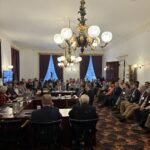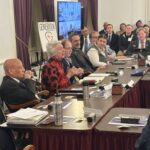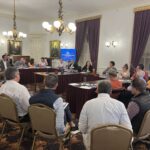Emily Hurd
64 Vermont Chamber Members Named 2025 Best of Business Winners
64 Vermont Chamber Members Named 2025 Best of Business Winners
The Vermont Chamber of Commerce congratulates our members who have been named recipients of the VermontBiz 2025 Best of Business Awards. This year, over 100 Vermont companies were recognized as the best in their category, including 64 Vermont Chamber members.
This awards program celebrates the best Vermont companies in more than 100 business-to-business categories. To identify the winners, VermontBiz surveyed magazine and digital subscribers, asking their readers – the business leaders of Vermont – who they trust to provide their services in 120 different categories.
Vermont Chamber members that were named to the 2025 list include:
|
Category: |
Winner: |
|
Best Hotel for Business Travel: Chittenden County |
Hotel Vermont |
|
Best Hotel for Business Travel: Franklin/Grand Isle/Addison Counties |
Basin Harbor |
|
Best Hotel for Business Travel: Central Vermont/Northeast Region |
Stoweflake Resort & Conference Center |
|
Best Hotel for Business Travel: Windham/Windsor Counties |
Woodstock Inn |
|
Best Credit Union: Chittenden County |
Vermont Federal Credit Union |
|
Best Credit Union: Franklin/Grand Isle/Addison Counties |
EastRise Credit Union |
|
Best Credit Union: Central Vermont/Northeast Region |
EastRise Credit Union |
|
Best Credit Union: Windham/Windsor Counties |
Vermont Federal Credit Union |
|
Best Bank: Chittenden County |
Community Bank |
|
Best Bank: Central Vermont/Northeast Region |
Community National Bank |
|
Best Small/Medium Venue for Meetings and Events: Chittenden County |
The Essex Resort & Spa |
|
Best Small/Medium Venue for Meetings and Events: Central Vermont/Northeast Region |
Stoweflake Resort & Conference Center |
|
Best Small/Medium Venue for Meetings and Events: Rutland/Bennington Counties |
Mountain Top Resort |
|
Best Small/Medium Venue for Meetings and Events: Windham/Windsor Counties |
Woodstock Inn |
|
Best Large Venue for Meetings and Events: Chittenden County |
Champlain Valley Exposition |
|
Best Large Venue for Meetings and Events: Franklin/Grand Isle/Addison Counties |
Basin Harbor |
|
Best Large Venue for Meetings and Events: Central Vermont/Northeast Region |
Stoweflake Resort & Conference Center |
|
Best Large Venue for Meetings and Events: Rutland/Bennington Counties |
Killington Grand Hotel |
|
Best Large Venue for Meetings and Events: Windham/Windsor Counties |
Woodstock Inn |
|
Best Golf Course: Chittenden County |
Burlington Country Club |
|
Best Golf Course: Franklin/Grand Isle/Addison Counties |
Basin Harbor |
|
Best Golf Course: Central Vermont/Northeast Region |
Stowe Country Club |
|
Best Golf Course: Rutland/Bennington Counties |
Green Mountain National |
|
Best Golf Course: Windham/Windsor Counties |
Lake Morey Resort |
|
Best Restaurant for Business Lunch: Chittenden County |
Windjammer Restaurant |
|
Best Restaurant for Business Lunch: Central Vermont/Northeast Region |
Sarducci’s |
|
Best Restaurant for Business Lunch: Windham/Windsor Counties |
Grafton Inn |
|
Best Restaurant for Business Dinner: Chittenden County |
Windjammer Restaurant |
|
Best After-Work Bar: Chittenden County |
Waterworks Food + Drink |
|
Best After-Work Bar: Franklin/Grand Isle/Addison Counties |
14th Star Brewing Company |
|
Best After-Work Bar: Central Vermont/Northeast Region |
Three Penny Taproom |
|
Best Bank Statewide: |
Northfield Savings Bank |
|
Best Credit Union Statewide: |
Vermont Federal Credit Union |
|
Best Website Developer: |
Eternity |
|
Best Travel Agency For Business Travel: |
Milne Travel |
|
Best Downhill Ski Area: |
Smugglers’ Notch Resort |
|
Best Cross Country Ski Area: |
Trapp Family Lodge |
|
Best Electricity Provider: |
Green Mountain Power |
|
Best Fuel Provider: |
Vermont Gas |
|
Best General Contractor: |
DEW Construction, ReArch Company |
|
Best Lumber Company: |
rk MILES, Inc. |
|
Best IT Service: |
Open Approach |
|
Best Telephone Service: |
Burlington Telecom |
|
Best Internet Provider: |
Comcast |
|
Best Copier Provider: |
SymQuest |
|
Best Commercial Printer: |
Paw Print & Mail |
|
Best Accounting Firm: |
Gallagher Flynn & Company LLP |
|
Best Commercial Real Estate Broker: |
V/T Commercial |
|
Best Property Management Company: |
Redstone |
|
Best Waste Removal Company: |
Casella Waste Services |
|
Best MBA Program: |
UVM |
|
Best Online Degree Program: |
Champlain College |
|
Best Employee Benefits Firm: |
The Richards Group |
|
Best Health Insurance Provider: |
BlueCross BlueShield of Vermont |
|
Best Large Health Care Provider: 600+ Employees |
University of Vermont Medical Center |
|
Best Boat Dealer: |
Saba Marine |
|
Best Vermont Made Product: |
Darn Tough Vermont |
|
Best Vermont Made Beverage: |
Barr Hill |
|
Best Vermont Made Food Product: |
Cabot Creamery Co-operative |
|
Best Bankruptcy Law Firm: |
Primmer Piper Eggelston & Cramer PC |
|
Best Corporate Law Firm: |
Gravel and Shea |
|
Best Intellectual Property Law Firm: |
Downs Rachlin Martin PLLC |
|
Best Manufacturer: |
Cabot Creamery Co-operative |
Congratulations again to our members who were recipients of the 2025 Best of Business in Vermont Awards.
RECENT TAX NEWS
Education Property Taxes and Affordability in Vermont
Choosing Progress: Vermont Chamber’s 2026 Legislative Priorities
Striking the Right Balance: Advocating for Equitable Property Tax Reform
Striking the Right Balance: Advocating for Equitable Property Tax Reform
This week, the Vermont Chamber testified in the House Ways and Means Committee on property tax classifications—an issue with far-reaching implications for education finance, business competitiveness, and overall economic stability. Vermont faces a pressing challenge: affordability is increasingly strained by rising property tax rates.
According to the U.S. Census Bureau, in 2023, Vermont ranked third in total taxes per capita ($6,948.15) and first in property taxes per capita ($1,870.04). This is a position Vermont has held since 1999, when the property tax per capita was $650.27. Adjusted for inflation—using an approximate multiplier of 1.7—that amount would be about $1,105 today. Instead, the current rate is around 70% higher, indicating that property tax burdens have surged well beyond general inflation, exacerbating affordability challenges for both residents and businesses.
The Core Issue
The Vermont Chamber of Commerce acknowledges the need for reform to address these affordability concerns. However, we have concerns about introducing new property tax classifications. Following testimony from the Vermont Chamber and industry stakeholders, revised classifications were introduced:
- Homestead
- Nonhomestead, Apartment
- Nonhomestead, Nonresidential
- Nonhomestead, Residential
While this revision reduces the nine categories initially reviewed by the committee earlier in the week, the Vermont Chamber remains concerned. The current proposal creates an opening for inequitable tax treatment by singling out businesses with a category specific to them. Introducing multiple new classifications could lead to:
- Increased Complexity: More categories may obscure accountability and reduce transparency.
- Administrative Inefficiencies: An expanded system could result in unpredictability and higher administrative costs.
- Unintended Business Impact: Additional classifications might impose higher or less favorable rates on businesses, discouraging investment and growth.
Recommendations for a Better Path Forward
To address the growing gap between property tax obligations and economic reality—while maintaining a system that is simple, equitable, transparent, efficient, and stable—the Vermont Chamber is advocating for legislators to combine the Nonhomestead, Apartment and Nonhomestead, Nonresidential categories into one Nonhomestead category. Both property types share similar market-driven and investment characteristics, which differentiates them from Nonhomestead, Residential properties. This consolidation would eliminate the potential for inequitable tax treatment of businesses and promote fairness across the board. Recommendations from the Vermont Chamber remain:
- Postpone or Scale Back the Expansion of Classifications: Delay or limit the introduction of new tax categories until a comprehensive analysis demonstrates clear benefits.
- Consolidate Similar Categories: Streamline the system by grouping similar property types to preserve clarity and fairness.
- Institute a Mandatory Regular Review Mechanism: Establish a periodic review process to ensure that the tax system remains responsive to economic changes and aligned with community needs.
Looking Ahead
The House Ways and Means Committee is expected to vote on this bill early next week. It is critically important that any property tax reforms enhance stability and fairness, not undermine them. By focusing on these core principles, Vermont can tackle its affordability challenges without creating a system that singles out businesses or adds unnecessary complexity. While there are concerns with the current proposal, we remain committed to staying at the table to ensure that the business community has a proactive voice and that any changes remain equitable, transparent, and supportive of economic growth.
Chamber Priorities Advance in Budget, Gaps Remain
Chamber Priorities Advance in Budget, Gaps Remain
The House passed H.493, the FY26 budget bill appropriating $9 billion. The budget as passed includes investments in housing, workforce, and infrastructure that echo many of the Vermont Chamber’s priorities. However, several important economic development tools were not fully funded, creating gaps that could impact business growth and workforce attraction in the years ahead. As the budget moves over to the Senate, there will be further opportunities to address these gaps.
Key Investments That Support Vermont’s Economy
- $7.5 million for the Vermont Housing Finance Agency Rental Revolving Loan Fund to support innovative housing finance models.
- $7.5 million for the Vermont Bank Infrastructure Sustainability Fund, providing a new funding source for community’s infrastructure needs.
- $10 million for the Middle-Income Homeownership Development Program, helping address the financial gap needed to develop middle income housing, long support by the Vermont Chamber.
- $2 million in base funding for the Manufactured Home Improvement and Repair (MHIR) Program, securing ongoing funding for an essential segment of Vermont’s housing stock.
- Funding for Advance Vermont, a key workforce initiative focused on upskilling and education-to-career pathways.
- Investment in the Vermont Professionals of Color Network, bolstering the organization’s workforce retention and recruitment efforts statewide.
- 3% base increases for UVM, VSAC, and Vermont State Colleges, supporting the state’s talent pipeline and higher education system.
- $650,000 in base funding to Sheriffs to restore vacancy savings, allowing transport deputy positions to be filled
- $650,000 in base funding to the State’s Attorneys to restore vacancy savings
Unmet Needs
- The Vermont Housing Incentive Program (VHIP) received $4.15 million in one-time funds, but its future remains uncertain as it wasn’t included in the base budget.
- No additional funding was provided for relocation assistance through the Grants for Relocation Outreach Work Program, a program intended to support local, regional, county, and statewide organizations conducting new resident relocation, recruitment, and retention activities.
Sustained, strategic investments remain critical to building a resilient economy. The Vermont Chamber will continue working to ensure that policies and investments promote long-term economic stability, business competitiveness, and bring Vermont towards a future of growth and abundance.
Vermont Manufacturing Day Brings Business and Policy Leaders Together at the State House
Vermont Manufacturing Day Brings Business and Policy Leaders Together at the State House
Over 100 manufacturing industry leaders gathered at the State House on April 2 to engage with legislators and raise awareness of the collective contributions of this industry to the Vermont economy. Vermont Manufacturing Day, convened by the Vermont Chamber of Commerce, Associated Industries of Vermont, Regional Development Corporations of Vermont, and Vermont Manufacturing Extension Center, brought businesses together to increase awareness, build relationships, and tell the story of the industry.
The Vermont Manufacturing economy has a $3 billion annual economic impact (over 8% of the state’s GDP), supports 30,000 jobs, and represents 10.5% of Vermont’s workforce. Businesses, legislative leaders, and Administration officials collaborated for a day of advocacy to elevate the collective contributions of the manufacturing sector to Vermont. Advocacy day highlights included a joint hearing with the Senate Committee on Economic Development, Housing and General Affairs and House Committee on Commerce and Economic Development, a listening session with Speaker Jill Krowinski, a listening session with Lieutenant Governor John Rogers, and a joint resolution recognizing April 2, 2025 as Vermont Manufacturing Day.
Rep. Jonathan Cooper (Bennington-1), shared “In this resolution, we affirm the value and necessity of a thriving manufacturing sector in the Green Mountain State. Accounting for more than 10 percent of Vermont’s private sector jobs, and boasting an average wage well above the statewide figure, the manufacturing industry provides a variety of high-quality, skilled jobs that are the backbone of our state’s economy. This sector plays a key role in both economic stability and prosperity, particularly in our rural communities,” commented Rep. Cooper.
“What sets Vermont manufacturers apart is their commitment to collaboration and continuous improvement. They are agile, people-focused, and solutions-oriented. And that culture of excellence is essential to building a more competitive, more resilient Vermont economy,” said Amy Spear, President of the Vermont Chamber of Commerce. “Manufacturing Day is more than a celebration—it’s a vital opportunity to connect Vermont’s business leaders and legislators. It’s how we strengthen understanding, build partnerships, and advance policies that support a thriving manufacturing sector.”
At the press conference, Vermont Commerce Secretary Lindsay Kurrle shared, “Manufacturers produce goods, create high-quality and high-paying jobs, and contribute to the economic success of Vermont. From aerospace to semiconductors and injection molding to socks – our manufacturing landscape is varied and thriving. At the Agency of Commerce and Community Development, our Department of Economic Development team is invested in manufacturing. We are committed to recruiting new businesses to Vermont and supporting the ones that are already here.”
“Manufacturers across Vermont face challenges including high energy costs, aging infrastructure, and a tight labor market. It’s important that we all work together to develop targeted programs that provide both immediate and long-term support to overcome these challenges,” said Alex Demoly, Vice President of the Greater Burlington Industrial Corp. “With continued industry support, we can help Vermont manufacturers modernize their facilities, improve their competitiveness, and expand their workforce development efforts.”
Business leaders highlighted the following sentiments in their testimonies: the role of manufacturing in helping to sustain a diverse economy that supports a range of other industries, the sector’s centrality in providing jobs and fostering innovation throughout the state, including in more rural communities, and the collective challenges facing businesses in the industry, including: workforce development and access to skilled labor, workforce housing accessibility and affordability, and rising costs.
“According to Deloitte, the U.S. is projected to have more than 2 million unfilled manufacturing jobs by 2030 nationwide. With Vermont’s aging population and a housing crisis, we are particularly vulnerable to being even further left behind,” said Diane Abruzzini. “There is momentum towards reshoring manufacturing back to the U.S. and Vermont has a real opportunity to be a part of that. To do so, we must address the structural challenges that make doing business here difficult, while building on the collaborative strengths that make Vermont a supportive place to grow.”
Additional business and policy leaders that testified were: Mike Rainville, Founder and Owner of Maple Landmark, Jim Tringe, Director of Plant Services at Cabot, Brian Kippen, President/CEO of KAD Models & Prototypes, Inc., Elizabeth Dunn, Director of Distribution and In-House Manufacturing at USA Brands, Alberto Aguilar, President and CEO at Carris Reels, and Meg Hammond, Executive Director of Generator.








SHARE THIS ARTICLE
RECENT NEWS
Healthcare Costs and Affordability in Vermont
Education Property Taxes and Affordability in Vermont
Balanced Data Privacy Bill Receives Unanimous Support in the Senate
Balanced Data Privacy Bill Receives Unanimous Support in the Senate
This week, the Vermont Senate unanimously passed a comprehensive data privacy bill, signaling strong bipartisan support for the protection of Vermonters’ personal data and Vermont’s economy. The bill, which was supported by Vermont business organizations, nonprofits, and medical providers, aligns with the privacy framework passed in other New England states and outlined in Governor Scott’s veto last year. By passing the bill, the Senate has sent a clear message: Vermonters deserve strong privacy protections, and Senate lawmakers are listening to the concerns of trusted local organizations.
During the Senate Economic Development, Housing, and General Affair’s review of the bill, Senate Majority Leader Kesha Ram Hinsdale expressed the Senate’s commitment to the bill, stating, “I will say on the record, if you touch a hair on this bill’s head it may not garner the votes in the Senate to pass.” This statement underscores the Senate’s resolve to keep the bill intact as it moves to the House. Despite external pressures from out-of-state interests trying to push Vermont toward more extreme policies, the Senate has prioritized a solution that balances privacy rights with the needs of Vermont’s economy.
The bill was reported by Bennington Senator Rob Plunkett, a meaningful moment for the businesses in his district, which have been a prominent voice on this issue. This action by the Senate highlights the importance of creating a privacy framework that protects local businesses from unnecessary legal risks. As the bill moves to the House, the Vermont Chamber hopes to see the same commitment to a regionally compatible approach that supports Vermont’s economy while safeguarding privacy. We thank the Senate for their thoughtful, bipartisan leadership and urge the House to follow this show of leadership.
Rethinking Property Taxes
Rethinking Property Taxes
The Vermont Chamber testified this week in the House Ways and Means Committee on proposed property tax classification changes, which will be a critical component to the future of education finance. From taxes to housing and healthcare, businesses and residents are grappling with mounting pressures. The message is clear: Vermont must address its most significant issues with bold, comprehensive reforms in order to remain competitive and economically resilient. A path toward sustainability and predictability is needed to support Vermont’s economic drivers.
The proposed system expands property classifications into nine distinct categories. Although this could enable a more nuanced tax framework, there are concerns about the feasibility of implementation. In the Vermont Chamber’s recent Business Climate Survey, 86% of businesses expected last year’s property tax increases to impact their financial health. We encouraged the committee to recognize the significant tax burden businesses face, to support investment and growth, and to ensure that Vermont remains competitive in attracting business investment.
While there are concerns with the current proposal, we remain committed to staying at the table to ensure that the business community has a proactive voice and that any changes remain equitable, transparent, and supportive of economic growth. Meaningful reforms will require all stakeholders to engage in difficult conversations.
As a member-driven organization, we value your feedback, which will help shape our advocacy work as we continue these conversations. Please consider taking this micro-survey to inform our efforts.
Halfway Point: Taking Stock of the Legislative Session and Vermont’s Affordability Challenges
Halfway Point: Taking Stock of the Legislative Session and Vermont’s Affordability Challenges
With crossover complete, the Vermont Chamber advocacy team provides a comprehensive status update on Vermont’s most pressing affordability issues—education and property taxes, housing, healthcare, and business cost and regulation. Early measures in education and property taxes show promise in easing financial pressures, while proposed reforms in housing and healthcare remain under review amid evolving priorities. Key issues are summarized below.
Education Finance and Delivery
Following an average property tax increase of 14% last year, Vermont’s education finance and delivery system has reached a critical inflection point. With a clear focus on progressivity, transparency, and local control, the Legislature is examining the Administration’s proposals, which aim to address nearly every aspect of the current education finance framework—from how property tax credits are calculated to new measures designed to reduce disparities among school districts. However, significant questions remain regarding the potential for cost containment and the methodologies that will be employed to achieve it.
- Yield Bill Passes Ways and Means: Curbing Property Tax Hikes: The House Ways and Means Committee passed the yield bill (9-2-0), proposing a uniform change to both non-homestead and homestead property tax rates for the upcoming fiscal year. The bill uses the one-time $77.2 million general fund transfer proposed by the Administration to buy down the property tax rate to an average increase of 1.1% versus the 5.9% increase that would have been realized without the transfer.
- Education Reform Gets More Time: Due to the complexity of education reform—covering proposed changes to district sizes, funding, governance of Centers for Technical Education (CTE), prekindergarten, and a potential shift to a foundation formula—lawmakers are expected to take additional time beyond the standard crossover deadline. These decisions will ultimately determine whether cost containment can be achieved this session.
Housing
The continued lack of affordable housing is making living in Vermont more challenging for workers and families. Thoughtful reforms—such as streamlining permitting, encouraging higher-density and mixed-use developments, and revising financing mechanisms—are needed to help stabilize prices, support community resilience, and increase housing output.
- Housing-Focused Infrastructure Financing Gains Momentum: Public infrastructure remains a major barrier to housing development. A housing-focused version of the long-proposed project-based Tax Increment Financing (TIF) program has gained momentum in the Senate, alongside a bond bank program designed to extend and enhance water and sewer service capacity for housing in municipalities.
- Middle Income Programs Get Policy Approval; Budget Approval Pending: Programs designed to bridge the financing gap for housing developers or homebuyers have received support in policy committees, although the final budget for these initiatives has yet to be determined.
- Act 250 Appeals Study Expedited: The timeline for a study on Act 250 appeals was expedited to allow the Legislature to develop policy proposals in time for the next session.
Healthcare
Commercial healthcare premiums have increased by double digits over the past three years while healthcare providers continue to face staffing and funding challenges in delivering the access to care communities need; 45% of respondents to the Vermont Chamber’s Business Climate Survey have adjusted their benefits in response to rising costs—with smaller businesses feeling the impact the most.
- Reference-Based Pricing: Reforms Under Consideration to Curb Costs: In efforts to control costs, the Senate is moving forward with a proposal to implement reference-based pricing (RBP) before phasing in global hospital budgets.
- New Law Unmerges Markets, Double-Digit Premium Increases Likely: In a swift legislative move, Vermont’s Legislature permanently unmerged the individual and group healthcare markets—a measure signed into law by Governor Scott—to shield small businesses from the higher costs of the individual market. However, the path to addressing the underlying cost drivers remains unclear and another year of double-digit increases may be unavoidable.
- Workforce and Demographic Challenges: Further Action Needed: While current programs remain essential, little progress has been made in developing solutions to address the growing staffing shortages and demographic shifts impacting the healthcare system. Additional proactive measures are needed to ensure long-term workforce sustainability and maintain access to quality care.
Vermont’s Business Climate
The Vermont Chamber’s Business Climate Survey revealed a stark reality: respondents consistently voiced frustration with Vermont’s business environment, citing rising operational costs, regulatory hurdles, and a lack of workforce availability. The Vermont Chamber’s focus remains aligned with what Vermonters expressed at the polls in November—addressing affordability, spurring economic growth, and tackling Vermont’s toughest challenges head-on.
- Military Retiree Pension Exemption Ignored: Despite strong bipartisan support in the House and Senate, legislation that would exempt the pensions of military retirees and survivor benefits from taxation has not been taken off the wall, leaving Vermont as the second least desirable state for military retirees. Vermont’s veteran population is declining at a rate of 2.7% annually, compared to a national decrease of 1.6%.
- Balanced Comprehensive Data Privacy Gains Traction: A Comprehensive data privacy bill has received unanimous committee approval as it moves through the Senate. While compliance with this law will carry costs, the bill aligns with data privacy standards in other New England states and avoids exposing businesses to costly legal fees by excluding a private right of action.
- Electricity Rate Increases: Two Senate committees have advanced a bill that is raising serious concerns due to its potential to increase electric costs for ratepayers.
- New Business Taxes and Fees Off the Table for Now: While new and increased taxes were front of mind last year, tax increases targeting Vermont businesses have been off the table thus far.
Looking Ahead: What’s Next for Affordability Policy?
As the Legislature moves into the second half of the session, many of these affordability proposals will face significant hurdles in securing final approval and funding, and things can change dramatically as bills move from one chamber to the other. Proposals that seemed settled in one committee may be completely rewritten or stalled as they face new scrutiny and ideology. Several efforts to deliver some form of affordability remain in play, but competing priorities and budget constraints will shape what ultimately moves forward. Adding to the uncertainty, federal funding fluctuations could impact healthcare, infrastructure, and workforce programs, forcing lawmakers to make difficult trade-offs. The Vermont Chamber will remain engaged at every step, ensuring that affordability remains at the forefront as these critical policies take shape.
SHARE THIS ARTICLE
RECENT NEWS
Healthcare Costs and Affordability in Vermont
Education Property Taxes and Affordability in Vermont
Intern Spotlight: Camden Simpson
Intern Spotlight: Camden Simpson

Name: Camden Simpson
College: Saint Michael’s College
Field of Study: History Major, Education and Music Minors
Anticipated Graduation: May 2026
Hometown: Barre, VT
What past or current experiences have prepared you for your internship with the Vermont Chamber of Commerce?
Prior to beginning my internship with the Vermont Chamber of Commerce, I took several classes that required extensive notetaking, as well as acute attention to detail. These experiences strengthened my skills and prepared me for my current tasks and responsibilities at the State House. I am also a musician who plays in ensembles both on and off-campus, which has prepared me to work collaboratively with large groups and ensure that large operations come to fruition. Although my role at the State House may be relatively minor compared to others, it still helps to ensure the success of the Vermont Chamber.
What are you most looking forward to/what do you enjoy the most as part of your internship experience? What skills are you developing?
As an intern with the Vermont Chamber, I most enjoy viewing the different policies and procedures undertaken by the legislatures in the lawmaking process. Since becoming a State House tour guide last summer, I have been most interested in how the building operates during the legislative session and how Vermont laws originate. Seeing it through my own eyes, while also being able to contribute to it in a small way, is truly exciting, and easily my favorite part of the internship. In terms of skills, I feel as if I am becoming a much better note taker, both in terms of how I record observations and how quickly I can get them down. My attentiveness is also improving, and I can record the most accurate depiction of what I witnessed.
What are your plans for after college?
After graduating college, I will likely pursue my Master of Education from Saint Michael’s College. I plan to become a teacher in my post-college years, and a master’s degree will assist me in acquiring licensure. I will also continue exploring different career options that are available with a bachelor’s in history, as well as taking time to explore different parts of the country and the world.
Anything else potential employers should know about you?
I hope that potential employers will take note of my work ethic and time management. I am a hard worker who is devoted to whatever cause I may end up working for. I am capable of managing my time well and planning out individual steps to tackle an assignment. These skills have allowed me to succeed in college thus far, and I am confident they will serve me well as I anticipate my entry into the workforce.
How should potential employers contact you?
Email – simpsoncamden84@gmail.com
Senate Institutions Committee Advances Balanced Data Privacy Bill
Senate Institutions Committee Advances Balanced Data Privacy Bill
The Senate Institutions Committee has unanimously (5-0-0) advanced a data privacy bill that reflects the needs and concerns of Vermonters, including the Vermont business community. The original proposal in S.71, heavily influenced by out-of-state special interests, contained extreme provisions which would have placed costly and unworkable burdens on local businesses. A similar version of the bill was passed last year but was ultimately vetoed by Governor Phil Scott due to concerns about its lack of regional compatibility and the inclusion of a private right of action. With testimony and advocacy from Vermont stakeholders, including the Vermont Chamber of Commerce, lawmakers have instead advanced a more balanced approach that aligns with the New England model of data privacy protections.
The revised bill strengthens consumer data protections while ensuring that compliance remains practical for businesses of all sizes. Importantly, the legislation does not include a private right of action, a provision which could result in an influx of lawsuits or threats of lawsuits against Vermont businesses, creating uncertainty and increased legal costs. Following the New England model, the committee supported a framework that promotes responsible data practices without stifling economic growth or innovation. The new version of the bill also addresses requests outlined in Governor Scott’s veto letter, ensuring that Vermont’s approach to data privacy aligns with regional standards and avoids placing undue burdens on local businesses and nonprofits.
The bill will now go before the full Senate for further debate and a vote before moving to the House for additional consideration. The Vermont Chamber will continue engaging with lawmakers to ensure that the final legislation maintains a strong balance between consumer privacy and business viability, while also meeting the standards set forth by Governor Scott. As the House begins its review, the Chamber encourages Vermont businesses to stay informed and involved in the process to ensure their voices are heard.




